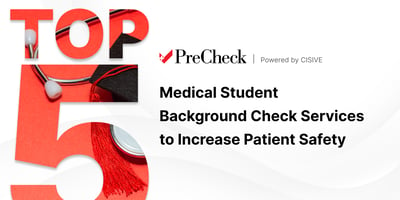

Hospitals, medical schools, and other healthcare organizations should screen medical students...

The Equal Employment Opportunity Commission (EEOC) has released its fiscal 2022-2026 strategic plan outlining its vision, goals, and objectives. Most U.S. workplaces are subject to the EEOC for background checks made when hiring, among many other workplace activities where discrimination is possible.
Learn more about the key changes within the EEOC Strategic Plan and how employers can adapt, including when it comes to background checks. You’ll also learn about best practices for background check compliance and how to identify a trusted partner to help you along the way.
The EEOC and other government agencies are required to publish a strategic plan every four fiscal years. These plans contain a mission statement and high-level goals and objectives. The EEOC must disclose how it intends to achieve those goals — and identify and disclose external factors that could prevent success.
The 2022-2026 plan will help the EEOC “fulfill our mission of preventing and remedying unlawful employment discrimination and advancing equal employment opportunity for all.”
The Strategic Plan is different from the EEOC’s Strategic Enforcement Plan, a periodic document that specifies the agency’s enforcement priorities for a multiyear period.
The EEOC doesn’t directly regulate background checks, but it has provided guidance to employers on best practices for conducting background checks to ensure compliance with anti-discrimination laws. In 2012, for example, the EEOC released enforcement guidance on the consideration of arrest and conviction records when making hiring decisions, and how that intersects with Title VII of the Civil Rights Act.
On top of EEOC regulations, there’s an additional layer of compliance for employers using a third party to compile background reports and information. These employers must also comply with other federal laws, including Fair Credit Reporting Act (FCRA) requirements enforced by the Federal Trade Commission (FTC).
Here’s a breakdown of the EEOC and FTC guidelines regarding what you can and can’t do at each stage of the employee background screening process.
Employers must take certain steps before obtaining criminal background information on potential employees. The EEOC says employers can’t discriminate against applicants or employees based on their race, national origin, color, sex, religion, disability, genetic information, or age. Additionally, employers shouldn’t ask for medical information before a conditional job offer is made.
The FTC states that employers must inform the applicant or employee of their intent to use background information for employment decisions, and they must receive written permission from the applicant or employee. Employers must also certify to producers of background check reports that they won’t discriminate against the applicant or employee.
The EEOC recommends that employers use consistent standards when gathering and using background information. For example, if you don’t hire a Black job applicant because of a past criminal drug offense but have hired white applicants with a similar history for the same role, the EEOC could consider that to be discriminatory. Discrimination against certain groups can lead to disparate impact against that group, which creates bigger organizational risks.
The FTC requires employers to provide applicants and employees with a copy of the background report and additional information before taking adverse action, such as firing an employee or revoking an employment offer. You must give the person an opportunity to explain negative information.
Recommended Reading: 4 Ways to Reduce Hiring Bias and Create a More Diverse Workforce
The EEOC requires employers to maintain employment records for one year after their origination or one year after those records were used to make an adverse employment decision — whichever comes later. If an employee is terminated voluntarily, you must retain their records for one year following their termination. If an applicant or employee files a discrimination charge against your organization, you must retain those records until the case gets resolved.
Once the period for preserving records has passed, the FTC dictates secure disposal of applicant or employee background reports.
The EEOC recently released its 2022-2026 Strategic Plan, which will inform its 2023-2027 Strategic Enforcement Plan. Here are some of the biggest goals of the latest Strategic Plan, and what new initiatives could mean for your background screening and hiring processes.
In the upcoming years, the EEOC intends to use its regulatory power to “identify and eradicate discriminatory policies and practices, including systemic practices” across federal agencies and the private sector.
Part of the EEOC’s plan for achieving this is to provide “targeted, equitable relief” through conciliations and resolutions. This relief will extend beyond monetary settlements for affected personnel to include actions designed to create a better work environment and prevent future violations.
These additional actions include “customized training for supervisors and employees, development of policies and practices to deter future discrimination, and external monitoring of employer actions, as appropriate.”
The commission is also examining the broader impact of cases by “industry, profession, company, or geographic region.” For example, in a state where recreational marijuana is legal, multiple employers are accused of illegally terminating workers based on off-duty use of marijuana.
Under the Strategic Plan, the EEOC will likely increase its “outreach and education, technical assistance, and enforcement, and will use all of them to achieve change on a broad scale.”
Recommended Reading: Top 6 Qualities of Inclusive Leaders
Another pillar of the EEOC’s 2022-2026 Strategic Plan is to increase public awareness of employment discrimination laws, as well as people’s rights and responsibilities under them. The commission is especially dedicated to increasing education and outreach efforts to historically marginalized groups.
The EEOC will also increase outreach to employers to “ensure broad awareness of EEOC’s litigation and other enforcement efforts, to the extent they may be made public.”
To this end, the EEOC will bolster its website’s educational material and increase its social media presence to reach a broader audience.
As the EEOC increases its digital offerings and accessibility, watch for additional educational material you can provide to talent management professionals and hiring managers — anyone who is running background checks and using that information to make employment decisions.
The EEOC’s draft Strategic Enforcement Plan, released in early 2023, includes an emphasis on workplace discrimination resulting from the use of artificial intelligence and other automated tools. EEOC staff are being trained on identifying such discrimination. Employers need to be aware of possible vulnerabilities and biases in their automated systems, including those used in background checks.
Every employer should develop robust, fair, and secure background screening processes. Here are six best practices to help you establish a compliant program.
Your background check program can vary based on several factors, including the types of roles you’re hiring for, the regulations in your industry, and state and local laws. Knowing the scope of your background check program will help you create a policy that’s tailored to your organization’s needs.
Background check policies should align with specific job requirements. For instance, roles that involve financial responsibilities may require more extensive financial background checks. Positions that involve working with vulnerable populations may call for comprehensive criminal background checks. And roles that handle sensitive data or confidential information may require additional checks, such as credit history checks for financial professionals or security clearance checks for government positions.
Industries such as healthcare, finance, and transportation are subject to specific regulations governing background checks. For example, healthcare employers must comply with the Health Insurance Portability and Accountability Act (HIPAA) when handling sensitive patient information, while financial institutions are regulated by agencies including the Securities and Exchange Commission (SEC) and the Financial Industry Regulatory Authority (FINRA).
Employers in regulated industries must adhere to industry-specific compliance standards when conducting background checks. Failure to do so can result in legal and regulatory consequence.
Factor local laws and regulations into your background check policy, as they may have additional or stricter rules to follow. Some states and localities have ”ban the box” laws, for example, that limit when and how employers can inquire about an applicant’s criminal history.
Other states ban the use of credit history checks for employment purposes or limit them to cases where it’s directly related to the job. Meanwhile, some states have enacted data privacy laws that may impact how background check data is collected, stored, and shared.
To avoid poor hiring results or discrimination claims, be consistent with background checks procedures. Some job roles might require stricter scrutiny, such as positions where people handle finances. But make sure you’re applying the same processes and standards to all applicants and employees within that job role or function.
Start by creating a clear and comprehensive background check policy. This document should outline the purpose of background checks, the types of checks required for different roles, and the criteria for disqualification based on the results. It should also specify the sources of information to be used (e.g., criminal records, credit reports) and the procedures for obtaining consent from job candidates.
Develop standardized procedures for conducting background checks, including the steps to follow, timelines, and documentation requirements. Ensure that all HR staff involved in the hiring process are trained on these procedures to maintain uniformity.
Maintain detailed records of all background checks conducted, including the results and the basis for adverse employment decisions. This documentation is crucial for demonstrating compliance with anti-discrimination laws.
Create a data retention policy that outlines your data storage processes, technology, and timeline.
Employ strong encryption techniques to protect data during transmission and storage. Data at rest and in transit should be encrypted to safeguard it from unauthorized access or breaches. Use secure servers, cloud storage solutions, or databases with built-in security features to store background check data.
Implement strict access controls to limit who can view and manipulate background check data. Only authorized personnel with a legitimate need should have access. Employ role-based access permissions — allowing access to HR staff, for example, but not employees across all functions.
Establish clear data-retention policies that specify how long background check data will be kept and when it will be securely deleted. Safely deleting unneeded data reduces the risk of data breaches.
Recommended Reading: Cybersecurity Concerns for Your Remote Workforce
Have an audit system in place to ensure that your background check program is compliant with local, state, and EEOC regulations. Regularly audit your program to ensure that it is fair and up to date.
Start by establishing clear objectives for your background check audit. Identify the specific aspects you want to assess, such as compliance, reporting accuracy, data security, or adherence to company policies.
Check that your adverse action procedures align with legal requirements. Compliant actions include providing candidates with pre-adverse action notices, allowing them to dispute inaccuracies, and providing final adverse action notices when applicable.
Assess whether HR staff are properly trained and aware of relevant policies, laws and regulations for conducting background checks and making hiring decisions. Make sure they understand the importance of fair and nondiscriminatory hiring practices.
If issues or discrepancies are identified during the audit, take prompt corrective actions. Develop an action plan to rectify noncompliance, improve processes, and improve data security.
Third-party vendors are available to conduct your background checks. They can ensure accuracy and protect your organization from potential liability.
Start by clearly defining your organization’s background check requirements. Consider the types of checks you need (such as criminal, credit, employment verification), the volume of checks you anticipate, and industry-specific compliance requirements. Healthcare, for example, is highly regulated in terms of licenses, credentials, and criminal records, so a healthcare-specific vendor like PreCheck is a good option.
Conduct thorough research to identify potential vendors. Beyond your own research, you can seek recommendations from industry peers or industry-specific associations, and explore online reviews and ratings.
Compile a list of vendors that align with your needs and reevaluate each firm’s reputation, compliance record, and experience. Look for accreditation from industry organizations like the Professional Background Screening Association (PBSA), which can indicate a commitment to high standards and ethical practices.
Make sure to update your background check program regularly. EEOC regulations and other laws are constantly changing. Your program shouldn’t fall out of compliance simply because you didn’t see an update.
Establish a system for monitoring changes in federal, state, and local regulations, including those related to background checks. A trusted vendor can help by identifying regulatory changes and automatically updating processes to maintain compliance.
Employers need to prioritize compliance with the EEOC for background checks and countless other activities. By following EEOC guidelines and adhering to anti-discrimination laws, you can promote background check processes that are fair, unbiased, and consistent. Take the initiative to practice responsible and ethical hiring practices that mitigate your legal risk and promote workplace diversity and inclusion.
For the best results, you need a trusted partner by your side. Schedule a meeting with one of our experts to solve all your employment background check challenges.

Hospitals, medical schools, and other healthcare organizations should screen medical students...

Before you hire a physician, you must conduct a thorough background check as part of the...

Healthcare organizations must meet stringent requirements when it comes to hiring nurses and other...